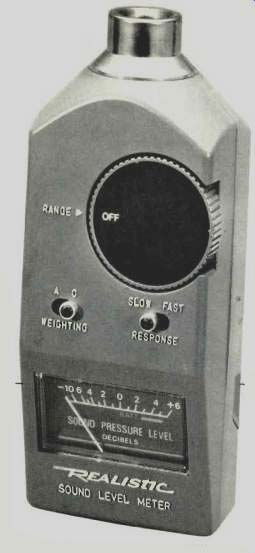
MANUFACTURER'S SPECIFICATIONS:
Range: 60 to 126 dB in six ranges.
Accuracy: ±2 dB @ 114 dB SPL.
Weighting: IEC "A" and "C."
Response: Fast or Slow.
A.C. Output: 1.0 V peak.
Distortion: Less than 2 percent @ 1 kHz and 0.5 V.
Microphone: Omnidirectional electret, one-in. diameter (nominal).
Weight: 7.8 oz (220 gms).
Price: $39.95.
The Realistic Sound Level Meter has reappeared, changed in configuration and improved in performance. Right now the price is the same low $39.95, but even if it increases ten dollars, this SLM still remains an outstanding bar gain. The meter fits very nicely in the hand with the scale at a convenient viewing angle. The large knob rotary range switch is easily turned with the thumb, provided you're right handed.
Immediately after the Off position is one for battery check, and then the SLM is set for increasing sensitivity from 120 to 70 dB in six 10-dB steps. The positions of the switch, except for Off, have red indications, which are obvious even in bright sunlight. The weighting can be set for either "A" or "C" and the dynamic response to either Fast or Slow. The scale is marked from "-10" to "+6" which are relative (in dB) to the range setting. Thus, the total specified range is from 60 to 126 dB SPL.
The electret microphone is a nominal 1-inch diameter which permits using a standard acoustical calibrator, such as the Gen Rad 1562-A. This feature is of great value in an SLM, especially when the price is considered.
Some units costing much more cannot be calibrated acoustically, lessening their value and making them more difficult to use. The calibration pot on the left side of the Realistic SLM enables zeroing any errors (One dB in the unit as received). A high-impedance mike output is available from a phono jack in the same side. The 9-V transistor-type battery is easily re placed from underneath, near the handy tripod socket.
Performance
The Gen Rad calibrator checked the SLM response from 125 to 2000 Hz for both weightings. With "C" weighting the unit just met the Type 3 requirements of ANSI standard S1.4-1971 for SLMs. With "A" weighting, the SLM met the more rigid Type 2 tolerances for the frequencies tested. The scale markings were too low below the "0" reference and too high above, but the maximum error was just 0.6 dB. The Attenuator steps were within a dB from 70 to 120 dB with a reference of 100 dB, very satisfactory. Compression was very rapid above "0" on the 120 range, however, and higher readings were unusable. Monitoring the high impedance mike output revealed that noticeable distortion of the sinewave started at 98 dB SPL. (The input was through a phone and coupler used for audiometer calibration.) As the thresh old did not vary with changes in the attenuator setting, it was diagnosed as an input circuit limitation. Clipping occurred on any range at +12 dB above the reference zero, or another 6 dB above full scale. On the higher scales, the output at the a.c. jack had signal-to-noise ratio of 52 dB with either weighting. On the most-sensitive 70-dB range, the ratios were 42 dB for "A" weighting and 32 dB for "C" weighting.
In-use Tests
The owner's manual is quite good with most important points covered very well in both text and illustration, and there is also a schematic. The comments on high-fidelity acoustics, however, are misleading. The SLM was very easy to operate, and the readings compared very closely with other, much-more-expensive SLMs with various frequency spectrums with the two weightings and for Fast and Slow responses. However, I would have preferred having the scales from -6 to +10 dB, making the total figure a simple addition most of the time. The good signal-to-noise ratio at the phono jack indicates the possibility of adding more sensitive ranges without much redesign. Well, that might be so, but the Realistic Sound Level Meter provides performance that should be completely satisfactory for most non professionals from 60 to over 110 dB SPL with either "A" or "C" weighting. It will tell you about listening levels, speaker dispersion, variations in audience coverage, etc., and more for a very good price.
--Howard A. Roberson
(Audio magazine, Nov. 1978 )
Also see:
Scott 451C Sound Level Meter (Nov. 1974)
Realistic 33-1080 Back-Electret Condenser Microphone (July 1983)
= = = =